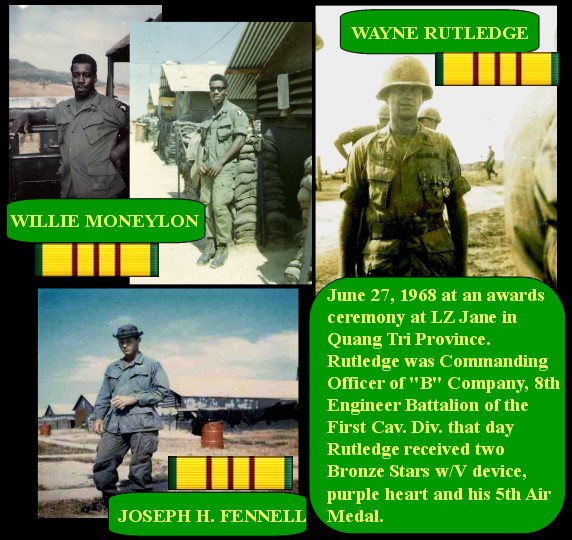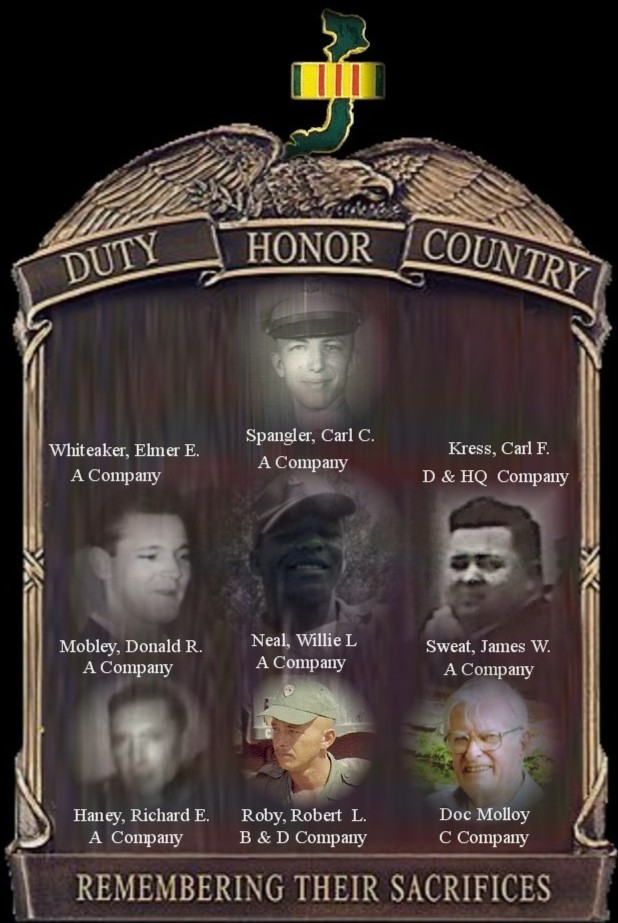|
All 82nd & D Company
237th Engineer members that served in VietNam, please sign the VietNam Vets page below.
Please provide the information requested. This page is long overdue. It should have been done years
ago to honor our 82nd & D Co. Engineer
VietNam veterans.
Page start up date, February 7, 2008.
Sign Vietnam Vet's Page View Vietnam Vet's Page
MEMEBRS THAT WE KNOW OF THAT HAD A TOUR IN
VIETNAM
MORE PHOTOS & NAMES WILL BE ADDED WHEN INFO COMES
IN.
WE DO NOT WANT TO LEAVE ANYONE OFF WHO SERVED IN
VIETNAM.














Carl C. Spangler
Casualty
Record for Carl C Spangler
GENERAL / PERSONAL - Home Bristol, Tennessee-Birth
Date 1935-09-18-Sex Male- Race Caucasian- Married/Single Married -Religion Baptist - Other Groups Citizen Yes MILITARY Service
Army Rank SSG Serial Number 13504928 Component Regular Grade E6- MOS 12B40- Length of Service 12 -Start of Tour 1965-09-25
-CASUALTY Date 1966-05-22- Casualty Type Hostile, Died Reason Multiple Fragmentation Wounds Country South Vietnam Province
And Military Region Unknown Posthumous Promotion No change- Body Recovered -Location on The Wall Panel 07E - Row 104
Sgt. James H. Duncan
D Company Member
No Photo
Casualty Record for James Henry Duncan
Home Pensacola,
Florida Birth Date 1933-10-29 Sex Male Race Caucasian Married/Single Married Religion No Preference Citizen Yes MILITARY Service
Army Rank SFC Serial Number 14432999 Component Regular Grade E7 MOS 11F40 Length of Service 14 Start of Tour 1966-12-17 CASUALTY
Casualty Date 1967-02-07 Casualty Type Hostile, Died Wounds Reason Gun, Small Arms Fire Air or Ground Ground Casualty Country
South Vietnam Province Province And Military Region Unknown Posthumous Promotion No change Body Recovered Body recovered
The Wall Panel 15E - Row 004
James H. Duncan



Escalation and ground war
Escalation of the Vietnam War officially started on the morning of January 31,
1965 when orders were cut and issued to mobilize the 18th TAC Fighter Squadron from Okinawa to Danang AFB. A red alert alarm
to scramble was sounded at Kadena AFB at 3:00 a.m. F-105's, pilots and support were deployed from Okinawa and landed in Vietnam
that afternoon to join up with other smaller units who had already arrived weeks earlier. Preparations were under way for
the first step of Operation Flaming Dart. The mission of Operation Flaming Dart, to cross the Seventeenth Parallel into North
Vietnam, was already planned and in place before the attack on Pleiku. The attack on Pleiku occurred on February 6, 1965.
On February 7, 1965 forty nine F-105 Thunderchiefs flew out of Danang AFB to targets located in North Vietnam. From this day
forward the war was no longer confined to South Vietnam. It took almost an hour to get all forty nine of the F-105's in the
air. On that morning, the continuous loud roar of the F-105 engines going down the runway, one following another, was described
by the ground crew as a "rolling thunder". At this time the Marines had not landed and Danang AFB was unprotected.
America's Longest War
The Vietnam War was the longest military conflict
in U.S. history. The hostilities in Vietnam, Laos, and Cambodia claimed the lives of more than 58,000 Americans. Another 304,000
were wounded. The Vietnam War was a military struggle fought in Vietnam from 1959 to 1975, involving the North Vietnamese
and the National Liberation Front (NLF) in conflict with United States forces and the South Vietnamese army. From 1946 until
1954, the Vietnamese had struggled for their independence from France during the First Indochina War. At the end of this war,
the country was temporarily divided into North and South Vietnam. North Vietnam came under the control of the Vietnamese Communists
who had opposed France and who aimed for a unified Vietnam under Communist rule. The South was controlled by Vietnamese who
had collaborated with the French. In 1965 the United States sent in troops to prevent the South Vietnamese government from
collapsing. Ultimately, however, the United States failed to achieve its goal, and in 1975 Vietnam was reunified under Communist
control; in 1976 it officially became the Socialist Republic of Vietnam. During the conflict, approximately 3 to 4 million
Vietnamese on both sides were killed, in addition to another 1.5 to 2 million Lao and Cambodians who were drawn into the war.
The Vietnam War was the longest and most unpopular
war in which Americans ever fought. And there is no reckoning the cost. The toll in suffering, sorrow, in rancorous national
turmoil can never be tabulated. No one wants ever to see America so divided again. And for many of the more than two million
American veterans of the war, the wounds of Vietnam will never heal. Fifty-eight thousand Americans lost their lives. The
losses to the Vietnamese people were appalling. The financial cost to the United States comes to something over $150 billion
dollars. Direct American involvement began in 1955 with the arrival of the first advisors. The first combat troops arrived
in 1965 and we fought the war until the cease-fire of January 1973. To a whole new generation of young Americans today, it
seems a story from the olden times.
No event in American history is more misunderstood
than the Vietnam War. It was misreported then, and it is misremembered now.
Richard
M. Nixon, 1985
On January 15, 1973, Nixon announced the suspension of offensive action against
North Vietnam. The Paris Peace Accords on "Ending the War and Restoring Peace in Vietnam" were signed on January 27,
1973, officially ending direct U.S. involvement in the Vietnam War. A cease-fire was declared across North and south
Vietnam. U.S. POWs were released. The agreement guaranteed the territorial integrity of Vietnam and, like the Geneva
Conference of 1954, called for national elections in the north and south. The Paris Peace Accords stipulated a sixty
day period for the total withdrawal of U.S. forces. "This article," noted Peter Church, "proved … to be the only one
of the Paris Agreements which was fully carried out.
Names for the conflict
Various names have been applied to the conflict, and these have
shifted over time, although Vietnam War is the most commonly used title in English. It has been variously called the
Second Indochina War, the Vietnam Conflict, the Vietnam War, and, in Vietnamese, Chiến tranh
Việt Nam (The Vietnam War) or Kháng chiến chống Mỹ (Resistance War against America).
- Second Indochina War: places the
conflict into context with other distinct, but related, and contiguous conflicts in Southeast Asia.
Vietnam, Laos, and Cambodia are seen as the battlegrounds of a larger Indochinese conflict that began at the end of World
War II and lasted until communist victory in 1975. This conflict can be viewed in terms of the demise of colonialism and
its after-effects during the Cold War.
- Vietnam Conflict: largely
a U.S. designation, it acknowledges that the United States Congress never declared war on North Vietnam. Legally, the
President used his constitutional discretion—supplemented by supportive resolutions in Congress—to conduct what
was said to be a “police action”.
- Vietnam War: the most commonly
used designation in English, it suggests that the location of the war was exclusively within the borders of North and South
Vietnam, failing to recognize its wider context.
- Resistance War against the Americans to Save the Nation:
the term favored by North Vietnam; it is more of a saying than a name, and its meaning is self-evident.
Its usage has been abolished in recent years as the government of Vietnam seeks better relations with the U.S. Official Vietnamese
publications now refer to the conflict generically as “Chiến tranh Việt Nam” (Vietnam War).

------------------------------------------------------------------------------
"LINKS
PAGES BELOW"





It has been a great honor for me to make
this page!
Eddie J. Cozart
|

